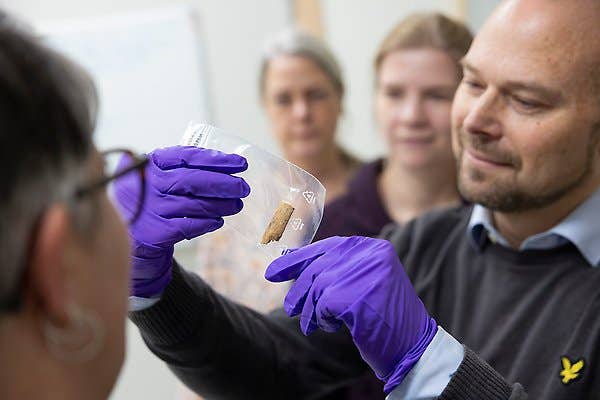Lifesaving study reveals the cause of Alzheimer’s disease and dementia
New research is uncovering a hidden driver of cell death in Alzheimer’s disease and vascular dementia, opening the door to fresh approaches in treatment.

Microglia, the brain’s resident immune sentinels, safeguard neural health by removing cellular waste and maintaining a balanced environment for nerve cells to function properly. (CREDIT: CC BY-SA 4.0)
New research is uncovering a hidden driver of cell death in Alzheimer’s disease and vascular dementia, opening the door to fresh approaches in treatment. Scientists have identified an iron-fueled process, previously overlooked in these disorders, that could explain part of their relentless progression.
A study from Oregon Health & Science University (OHSU), published in Annals of Neurology, pinpoints ferroptosis—an iron-dependent form of cell death—as a critical factor behind the loss of microglia in the brain. These findings suggest a new cellular target for slowing or halting disease.
Exploring Microglia and How They Shape Brain Function
Microglia are the brain’s immune sentinels, constantly on patrol to protect neural health. They clear dead cells, mop up waste, and keep the brain’s environment balanced. When the myelin coating on nerve fibers suffers damage, microglia rush in to clean away the debris, a step vital for protecting nerve function.
The OHSU team found that this rescue mission has a hidden cost. As microglia engulf damaged myelin, which is rich in iron, they trigger ferroptosis within themselves. The buildup of iron disrupts their function and eventually destroys them. Without these defenders, the brain’s capacity to manage injury and maintain stability weakens, accelerating disease progression.
This self-destructive cycle may be a crucial link between myelin damage and the worsening of dementia symptoms. By uncovering the mechanism, researchers hope to inspire therapies that protect microglia while they perform their cleanup duties. It also shifts the focus toward iron regulation in the brain as a possible therapeutic path.
Breakthrough Methods Uncover Fresh Understanding
The investigation drew on post-mortem brain tissue from people who had Alzheimer’s disease or vascular dementia. Under the leadership of senior author Stephen Back, M.D., Ph.D., the team examined how ferroptosis unfolded within microglia and connected it to myelin-related injury.
“This is a major finding,” said Dr. Back, whose career has long focused on myelin research, especially in the context of developmental delays in premature infants. “These results extend that work by revealing how neurodegeneration is intertwined with the breakdown of myelin.”
Related Stories
- Diabetes drug Semaglutide might protect the brain from dementia
- Daily internet use could prevent dementia, study finds
- Scientists develop game-changing Alzheimer’s drug that reverses brain damage
The innovative technique that made this discovery possible was spearheaded by the study’s lead author, Philip Adeniyi, Ph.D., a postdoctoral researcher in Dr. Back’s laboratory. This cutting-edge method brought into sharp focus the role of microglia in the white matter regions of Alzheimer's and vascular dementia patients' brains.
Dr. Back, reflecting on the significance of these findings, remarked, “We’ve missed a major form of cell death in Alzheimer’s disease and vascular dementia. It’s just amazing that we missed this until now.”
Implications and Significance
It's a revelation that's set to transform the way we perceive Alzheimer’s and vascular dementia. Co-author Kiera Degener-O’Brien, M.D., was the first to notice microglial degeneration in tissue samples. Building on this, Adeniyi's immunofluorescence technique confirmed that it was iron toxicity from myelin fragments leading to this degeneration. In essence, these immune cells were succumbing while performing their protective functions.
Dr. Back highlighted the previously underestimated role of microglia, saying, “Everyone knows that microglia are activated to mediate inflammation. But no one knew that they were dying in such large numbers.”
These findings have broad implications. The progressive decline of microglia may very well be a driving mechanism behind the cognitive deterioration seen in Alzheimer’s and vascular dementia patients. Recognizing this, Dr. Back anticipates a surge of interest from the pharmaceutical industry.
The Way Forward
“That’s where the field will go next,” he asserted, hopeful about the development of compounds targeting microglial degeneration.
The starting point of this degenerative cycle likely roots back to repeated episodes of reduced blood flow and diminished oxygen supply to the brain. Factors such as acute stroke or chronic conditions, including hypertension and diabetes, might be contributing culprits.
Dr. Back concluded with a profound thought, “Dementia is a process that goes on for years and years. We have to tackle this from the early days to have an impact so that it doesn’t spin out of control.”
As we stand on the cusp of this breakthrough, the field of dementia research has received a renewed impetus. This discovery, encapsulating the pivotal role of ferroptosis, presents an untapped reservoir of opportunities for scientists, researchers, and pharmaceutical pioneers. Only time will tell how this newfound knowledge shapes the future of dementia care and therapeutics.
Note: Materials provided above by the The Brighter Side of News. Content may be edited for style and length.
Like these kind of feel good stories? Get the Brighter Side of News' newsletter.



